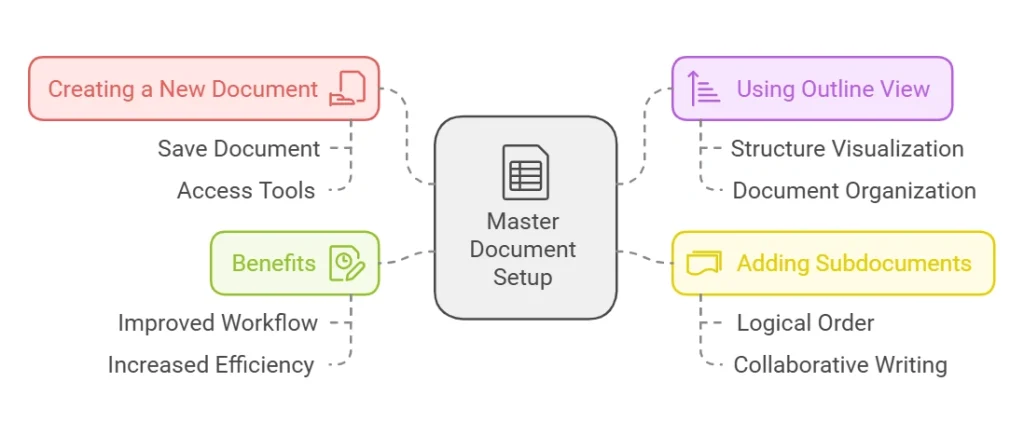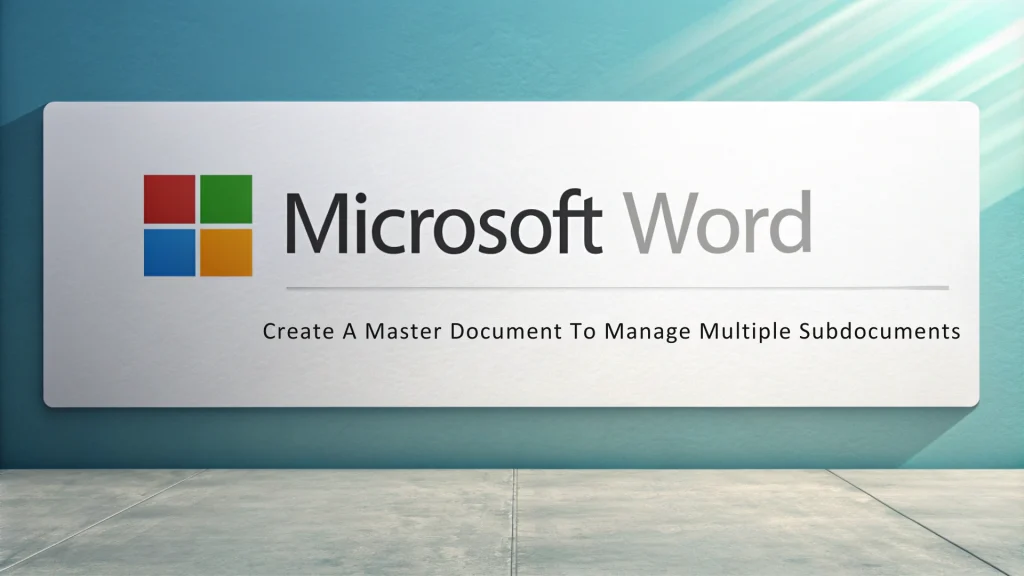Creating a master document in Microsoft Word simplifies managing multiple subdocuments, making it necessary for large projects. Imagine a master document as a binder that organizes smaller documents for easy access and editing.
Think of a puzzle: each piece is significant, but only when assembled do we see the full picture. A master document connects ideas and ensures organization in your writing. Let’s explore how to create one and improve your document management!
Setting Up the Master Document Environment

Setting up a master document in Microsoft Word is a powerful way to manage multiple subdocuments, especially for large projects. Think of it as assembling a puzzle; each piece represents a subdocument, while the master document shows how they fit together.
Start by creating and saving a new document. Next, open the Outline view by selecting the View menu and choosing Outline. This view clearly outlines your document’s structure. Click on the Show Document option to access tools for adding subdocuments. Each subdocument can be edited separately, making this setup ideal for collaborative writing and version control.
As you add subdocuments, keep a logical order since the master document displays them in the sequence they are inserted. This approach simplifies document management and improves content organization. For example, when writing a book, each chapter can act as a subdocument, streamlining both editing and management.
Effectively utilizing a master document can greatly improve your document workflow and increase in general efficiency in project planning and execution.
Choosing the Right Software
Choosing the right software for document management is necessary for effective content organization and document structure. A well-designed master document allows for easy linking of multiple subdocuments, simplifying the management of large projects like reports or books.
Consider these key points:
- Document Management: A master document keeps everything organized.
- Collaborative Writing: Multiple users can work on different subdocuments without confusion.
- Version Control: Updates in subdocuments automatically reflect in the master document.
To create a master document, follow these steps:
- Open Microsoft Word and create a new document.
- Save it as your master document.
- Use the Outline view to add subdocuments.
Utilizing a master document streamlines project documentation, enhances file organization, and supports efficient document workflow. For example, when writing a book, you can draft each chapter separately and link them, making editing and formatting much easier.
Plus, using templates ensures consistent formatting styles. When everyone follows the same guidelines, documents look professional and polished, which is critical for meeting documentation standards in any project.
Choosing the right software for document management profoundly affects how we organize and collaborate on our work. With the right tools, we can create a seamless document assembly process that boosts productivity.
Understanding Document Structure
Understanding document structure is necessary for effective document management. A master document serves as a central hub, linking multiple subdocuments for easy access and organization. This hierarchical format supports a clear content organization strategy, particularly in collaborative writing projects.
Creating a master document allows for seamless integration of different sections. When editing a subdocument, changes automatically reflect in the master document, providing a real-time overview of the project. For more tips on enhancing document management, explore advanced features that can lift your workflow.
In project documentation, a master document is critical for maintaining version control. It helps track changes and keeps everyone aligned. Imagine writing a book: each chapter is a subdocument, while the master document organizes and formats everything.
Here are key benefits of using a master document:
- Efficient editing: Modify individual subdocuments without disrupting the entire project.
- Structured assembly: Create a together document complete with a table of contents and headers.
- Collaborative ease: Share specific subdocuments with team members for focused contributions.
By mastering document structure, we improve our document workflow, ensuring projects are well-organized and easily accessible. This approach not only saves time but also boosts in general productivity.
Creating and Inserting Subdocuments
Creating and inserting subdocuments into a master document is necessary for effective document management. This method organizes content hierarchically, making navigation and editing easier. Follow these steps:
- Create a master document: Open Microsoft Word and save your document as the master file.
- Access Outline View: Go to the View menu and select Outline to structure your document.
- Show Document: Click Show Document in the Outline tools to allow subdocument features.
- Insert subdocuments: Click Insert, choose a subdocument, and select the files to link.
- Edit and manage: Double-click any subdocument link to edit. Changes automatically save in the master document.
This approach enhances project documentation and fosters collaborative writing. By linking modular documents, you maintain a clear file structure and make sure effective version control, streamlining your workflow.
| Step | Action |
|---|---|
| 1 | Create a master document |
| 2 | Access Outline View |
| 3 | Show Document |
| 4 | Insert subdocuments |
| 5 | Edit and manage |
Linking Existing Documents
Linking existing documents is necessary for effective document management. By creating a master document, you can connect multiple subdocuments, ensuring a clear document structure and efficient content organization.
A master document helps manage different aspects of project documentation, such as version control and collaborative writing. In group projects, for instance, you can assign different sections to team members. Each person edits their part independently, facilitating smooth document assembly.
To link subdocuments, create a new document and save it as your master file. Open the Outline view in Microsoft Word and use the Show Document option to insert your subdocuments, allowing for easy addition, removal, or rearrangement.
Linking subdocuments ensures that any edits automatically update in the master document. This feature is critical for maintaining documentation standards and testing all team members aligned with the latest information. For detailed steps on managing your documents, refer to this pagination guide.
Linking existing documents promotes a together and organized project. Utilizing a master document streamlines your workflow and enhances your digital content management practices.
Creating New Subdocuments
Creating new subdocuments is necessary for effective document management. By dividing content into smaller sections, you improve content organization and streamline collaborative writing. For example, when working on a large project, using separate files for each chapter or section is far more manageable than handling one enormous document.
Start by opening Microsoft Word and creating a new document, which you will save as your master document. Then, switch to Outline view by selecting the View menu and clicking on Outline. This step is critical for managing your subdocuments effectively. Click on Show Document to access the tools needed for inserting subdocuments.
With the tools prepared, select the content you want to convert into a new subdocument. Insert it by clicking on the Insert tab and choosing the appropriate option. This process helps maintain a clear hierarchical structure within your project documentation.
As you add subdocuments, rearranging them to fit your desired order is simple. This flexibility is critical for a coherent document structure. To edit any subdocument, double-click its link in the master document. This feature ensures seamless version control, automatically updating all changes.
During your document assembly process, consider using templates to optimize your workflow. By following these steps, you can create a well-organized, modular document that enhances your in general productivity.
Managing Document Workflow and Collaboration
Streamline your document workflow and collaboration with a master document and subdocuments. A master document acts like a central binder, organizing links to smaller subdocuments. This structure keeps projects tidy and efficient. For instance, when writing a book, each chapter serves as a subdocument linked to the master document. Any edits made in a subdocument automatically update in the master document, ensuring everything stays current.
To create a master document, begin by drafting your subdocuments. Open Microsoft Word, go to the View tab, select Outline, and click Show Document. Here, you can insert your subdocuments. This method promotes collaborative writing, enabling multiple team members to work on different sections simultaneously. You can also set editing permissions to control who can make changes.
Using a master document enhances file organization and boosts document management. It supports version control and simplifies document sharing. For detailed steps on managing these documents, check out this guide.
Version Control Practices
Version control is necessary for managing master documents and their subdocuments. It allows us to track changes and revert to earlier versions when needed. This practice is especially valuable in collaborative writing, where multiple team members contribute. By adopting version control, we maintain an organized and efficient document workflow.
- Document Tracking: Keep track of edits made by each collaborator to make sure clarity.
- Editing Permissions: Manage who can make changes, protecting document integrity.
- Feedback Integration: Effortlessly incorporate suggestions from team members for better results.
To create a master document, draft all subdocuments initial. This method allows for effective linking and a clear document structure. For detailed steps, check this guide on creating a master document.
Using cloud storage enhances our version control efforts, making it easy to share and access documents anytime. This integration supports our project management goals and ensures compliance with documentation standards.
Mastering version control practices is critical for effective document management and collaboration. It streamlines workflows and enhances team productivity.
Document Assembly Techniques
To improve our document workflow, we can use document assembly techniques. This process involves creating a master document that links to different subdocuments, ensuring a clear document structure and improved content organization.
Here’s how to create a master document:
- Create subdocuments: Draft each section separately.
- Open the master document: Use the Outline view in Word.
- Insert subdocuments: Link them to the master document.
This method promotes collaborative writing and effective version control. Changes made in subdocuments automatically update in the master document, which is critical for teamwork. It also simplifies the management of editing permissions and tracking changes.
For detailed instructions, check this guide on working with subdocuments.
By mastering these techniques, we can streamline our project documentation and improve file organization. This approach not only saves time but also remarkably boosts productivity.
Summing up
Creating a master document simplifies the management of multiple subdocuments. This organization ensures clarity and accessibility, similar to a well-arranged binder that allows for quick access to smaller papers. By developing a master document, we increase teamwork and improve project management. Let’s start crafting our master document to enjoy the benefits of organized writing!
Frequently Asked Questions
How can I make sure consistency across subdocuments in a master document?
en: Use styles for headings and formatting in subdocuments, ensuring uniformity when linked to the master document.
What tools can I use to create and manage a master document with subdocuments?
Use Microsoft Word’s Master Document feature under the View tab, or create a new document and insert subdocuments for easy management.
When a master document is created all Subdocuments are saved as individual files?
Yes, when you create a master document, all subdocuments are saved as separate files, allowing for easy management and editing.
What are the best practices for organizing a master document with multiple subdocuments?
en: Draft all subdocuments initial, use clear headings, maintain consistent formatting, and regularly update the master document for cohesion.
1 thought on “How To Create A Master Document To Manage Multiple Subdocuments”
Comments are closed.


Pingback: Mastering OneNote Web Clipper for Efficient Research | MSW Tutor.